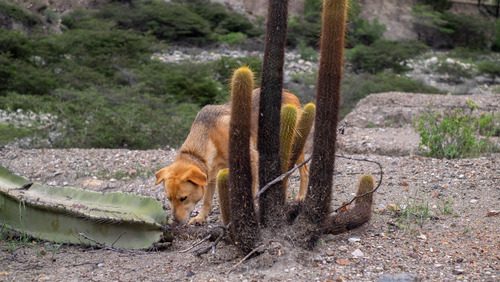As a dog owner in Fort Mohave, AZ, you’re probably familiar with the various plants native to the desert landscape. One plant that might catch your eye is the cactus, known for its unique appearance and resilience in harsh conditions. But when it comes to your dog’s safety, you might wonder, “Can dogs eat cactus?” This blog will explore everything you need to know about dogs and cacti, from potential risks to what you should do if your dog decides to take a bite out of one.

Is Cactus Safe for Dogs?
When it comes to the question, “Can dogs eat cactus?” the answer is not straightforward. While some cacti may not be toxic, most cacti species pose significant risks to dogs due to their sharp spines and irritating sap.
The Risks of Sharp Spines
Cacti are known for their sharp spines, which are a natural defense mechanism to deter animals from eating them. These spines can easily injure your dog if they attempt to bite or play with a cactus. The spines can puncture your dog’s mouth, tongue, and throat, leading to pain, swelling, and even infection if not properly treated. In more severe cases, if the spines are swallowed, they can cause internal injuries that may require surgical intervention.
Irritating Sap and Toxicity
Some cacti species, such as the prickly pear, have a sap that can irritate a dog’s mouth and digestive system. While not all cacti are toxic, the sap of some varieties can cause nausea, vomiting, and diarrhea. Even if the cactus itself is not toxic, the discomfort from ingesting the sap or spines can lead to a distressed and uncomfortable pet.
What Happens If My Dog Eats Cactus?
If your dog manages to ingest part of a cactus, you may notice symptoms ranging from mild discomfort to more severe reactions. Be sure to monitor your dog closely and seek veterinary care if symptoms persist or worsen.
Symptoms to Watch For
Common symptoms of cactus ingestion in dogs include:
- Drooling
- Pawing at the mouth
- Vomiting
- Diarrhea
- Refusing to eat or drink
- Signs of an internal injury, such as blood in the vomit or stool, difficulty breathing
- Signs of shock like pale gums and lethargy
Immediate Steps to Take
If you suspect that your dog has eaten cactus, remove any visible spines from their mouth or body carefully. Be gentle to avoid pushing the spines further into their skin. After removing the spines, rinse your dog’s mouth with water to help reduce irritation. Do not induce vomiting, as this could cause more harm if the spines are swallowed. Instead, contact Advanced Animal Care at 928-770-4918 to have your dog examined and treated by a professional.
How to Prevent Cactus-Related Injuries
Here are some practical steps you can take to ensure your dog stays safe around these spiky plants.
- Cactus-Free Zones in Your Yard: If you have a yard, consider creating cactus-free zones where your dog can roam freely without the risk of encountering these plants. You can also fence off areas where cacti are present or replace them with dog-safe plants that won’t pose a threat to your pet.
- Training and Supervision: Use positive reinforcement to teach your dog to stay away from cacti and other potentially harmful plants. Additionally, supervising your dog while they’re outside can help prevent accidental cactus encounters. If you’re out on a walk, keep your dog on a leash to control their movements and avoid areas where cacti are present.
What Cactus Alternatives Are Safe for Dogs?
If you love the look of cacti but want to ensure your dog’s safety, consider some dog-friendly plant alternatives. There are plenty of non-toxic succulents and other desert plants that can add beauty to your home or garden without posing a risk to your furry friend.
Dog-Friendly Succulents
Succulents like Haworthia and Echeveria are great alternatives to cacti. These plants are non-toxic and don’t have sharp spines, making them safer options for homes with dogs. These succulents also thrive in desert climates, making them a perfect choice for Fort Mohave residents who want a low-maintenance, dog-safe garden.
Cactus Look-Alikes
Some plants mimic the appearance of cacti without the associated risks. For example, the African Milk Tree (Euphorbia trigona) has a similar shape to some cacti but lacks the sharp spines. However, it’s important to note that while it doesn’t have spines, the sap of Euphorbia plants can still be irritating if ingested, so it’s best to keep these plants out of your dog’s reach.
When Should I Take My Dog to the Vet?
Even with the best precautions, accidents can happen. If your dog exhibits severe symptoms after coming into contact with a cactus, such as persistent vomiting, difficulty breathing, or signs of internal injury, it’s time to contact your veterinarian at Advanced Animal Care. These symptoms could indicate a more serious issue that requires immediate medical attention. Call us at 928-770-4918 if you’re unsure about your dog’s condition.
Regular Check-Ups and Advice
During routine wellness appointments, your vet can provide advice on how to protect your dog from common desert hazards and offer guidance on what to do in case of accidental ingestion. If you have any concerns about your dog’s interactions with cacti or other plants, schedule an appointment with Advanced Animal Care to discuss the best course of action.
Protecting Your Dog in a Desert Environment
Living in Fort Mohave, AZ, means you and your dog are surrounded by a unique desert environment, complete with cacti and other potentially hazardous plants. While cacti can be a beautiful part of your landscape, be aware of the risks they pose to your dog. By taking preventive measures, training your dog, and knowing when to seek veterinary care, you can help keep your dog safe and healthy in this rugged terrain. If you have any concerns or need further advice, call Advanced Animal Care at 928-770-4918 or request an appointment today.
